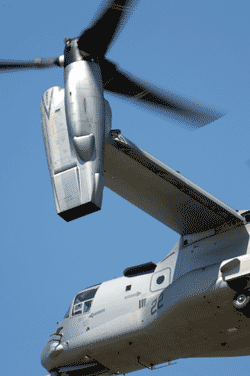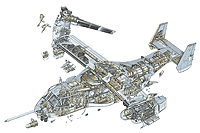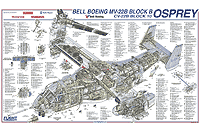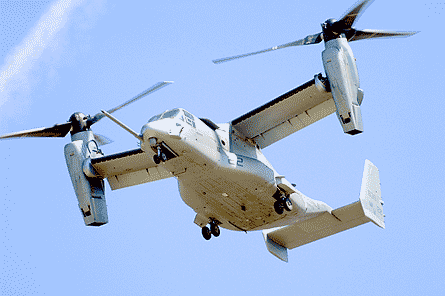By Graham Warwick in Patuxent River
 |
|---|
| The first Block B MV-22s are being delivered to the first operational USMC squadron |
For the Marine Corps, the first transatlantic excursion by two production MV-22s - although more eventful than planned - has served as a dress rehearsal for the Osprey's operational debut, planned for September next year, but which could come earlier if US commanders in Afghanistan and Iraq decide the tiltrotor's capability and survivability is needed urgently.
This is not the first overseas excursion debut for the Osprey, which was flown at the Paris air show in 1995. Then the MV-22 was expected to be approved for full-rate production in December 2000. But, after an operational pause and design modifications following two fatal crashes that year (see box), the go-ahead was delayed until September last year, and came only after operational evaluation had confirmed that the tiltrotor was at last safe and effective.
Transition time
| MV-22 Osprey |
 |
| After a difficult development, the world's first production tiltrotor is within months of becoming operational, and possibly a war zone deployment. This article forms part of a series |
| Farnborough: Osprey lifts off |
| Farnborough: Lessons learned brought V-22 back from the brink |
| Farnborough: Fifty-year journey to a new way to fly |
| Other recent articles from Flight publications include: |
| Riding the storm: Flight Daily News flies the Bell Boeing V-22 Osprey tiltrotor at Farnborough |
Or download our exclusive cutaway pictures with or without key from the Flight Archive |
 |
Now the tiltrotor is at a pivotal point, completing its transition from development to production and accelerating towards operation. The first combat-ready Block B MV-22 was delivered in December last year; the first USMC operational medium-lift squadron is working up; and Bell and Boeing are ramping up production from the minimum sustainment rate of 11 a year maintained during the operational pause.
"The focus has shifted from a development programme to an 'ordinary' in-production and in-service programme," says Col Bill Taylor, V-22 joint programme manager. As production ramps up, attention is switching from the aircraft's capability to its cost. Hopes of driving down unit cost from the current $69.9 million for the MV-22 are, in turn, focused on the multi-year procurement (MYP) of up to 185 aircraft over five years - including up to 26 of the US Air Force special-operations CV-22 variant, which currently costs $89.1 million because of its more extensive and expensive electronic-warfare suite.
Bell Boeing has just received the request for proposals for the MYP, so the number of aircraft to be procured, and at what unit cost, has still to be determined, but the "utopian figure" is $58 million in fiscal year 2010, says Taylor. The contract, targeted for award in mid-2007, covers aircraft purchases from FY2008 to FY2012, and is expected to be followed by a second MYP for the remainder of the 360 aircraft planned for the USMC, 50 CV-22s for the USAF and 48 MV-22s earmarked - but not yet budgeted - for the US Navy.
Under the MYP, production of the Osprey is targeted to ramp up to 37 MV-22s a year by FY2012, plus a steady five CV-22s annually. But with the increasing pressure on the US Department of Defense's budget vying with the Marine Corps' increasingly urgent need to replace its 40-year-old Boeing CH-46 helicopters, it is not clear whether this figure will be achieved - or exceeded. Bell chief executive Mike Redenbaugh says the team has looked at rates as high as 48 a year, but expects production to stabilise "in the 30s" annually.
Reducing cost is seen as critical to ensuring the Osprey avoids budget cuts, and the Bell Boeing team has been heading in the right direction, with unit cost of the MV-22 already reduced from $78 million. "The last four [production] lots have beaten the target price for each lot by $1 million a copy," says Taylor. "And each lot has reduced the unit recurring flyaway cost by $1 million over the previous lot." Despite this year-by-year progress, "the MYP is critical", says Taylor. Mike Tkach, Boeing vice-president and general manager rotorcraft systems, says: "We are hopeful, if we can get the price down, we will be a less attractive target for budget cuts."
Back on track
Production is also back on track in terms of deliveries and quality. After a long history of late deliveries, the team was back on schedule by the end of last year and is now ahead of schedule, having delivered the July aircraft in May, says Tkach. Quality problems resurfaced when production switched to the improved Block B last year, but have receded since then. "There were some quality issues with Block B, as there were with Block A. Aircraft deficiency reports had declined over time, then we went into Block B and there was another spike. But after just five aircraft, we were back to where we should be," says Taylor. "We are doing a lot better this year," says Tkach.
The Osprey is being developed and fielded in stages, with Block A representing the safe and efficient configuration incorporating design changes resulting from extensive investigation of the two crashes in 2000. These include electrical and hydraulic line clearance improvements and flight-control software changes. Bell Boeing has produced or modified 29 Ospreys to the Block A standard, 20 of which will remain in that configuration and be used for training and testing.
 |
|---|
| The redesigned aircraft has a system to warn when it is approaching vortyex ring state conditions |
These include ice protection and new troop seats, both expected to ready by May. An internal auxiliary fuel tank and telescoping in-flight refuelling probe are in development testing and scheduled to be qualified by March (the Ospreys sent to Farnborough have the auxiliary tanks, but retain the original fixed probes). A defensive weapon system - ramp-mounted M240 machine gun - is also in testing and is to be ready by February. A hoist, and fast-rope capability, was cleared in April this year. Other pre-deployment work still to be completed includes expanding the number of different ship types from which the MV-22 can operate.
Block C MV-22s - and the equivalent Block 20 CV-22s - will incorporate a number of pre-planned improvements, including a more-robust environmental control system "to reduce temperatures for guys in the back", says Taylor. A situational-awareness display will be added in the rear cabin for the crew chief, and forward-facing ALE-47 countermeasures dispensers will be added to improve self-protection. Block C will also tackle avionics obsolescence issues.
 |
|---|
| The two MV-22s displayed at Farnborough were in an experimental colour scheme |
While all but 20 Block As will be brought up to Block B standard, there are no plans to retrofit the Block C upgrades, says Taylor. He expects Block C to be the final new-production configuration for the Osprey, with Block D likely to be an upgrade of in-service aircraft, "as we will be so far through production", which is to continue to 2017 under current plans.
With the Osprey through operational evaluation and into full production, efforts to attract export customers are being stepped up. Several countries have expressed interest, Bell Boeing says, and demonstrations were scheduled during Farnborough, but there are no active foreign military sales cases yet, says Taylor, who expects Block B to be the baseline configuration for export.
Although the "baseline threshold" for initial operational capability (IOC) of the MV-22 is September next year, Taylor says the decisions on declaring IOC and deploying the aircraft are independent. A number of factors determine IOC, including availability of aircraft and trained crews. The first operational squadron, VMM-263 formed in March, will have nine aircraft by November and its required complement of 12 MV-22s by February. "I believe the programme will be ready to deliver IOC no later than summer 2007, possibly as early as spring," he says.
If USMC commanders decide to send the Osprey into the operational theatre early, the tiltrotor assault transport could be deployed by ship - probably an LHA helicopter carrier - but more likely they would self-deploy to the Middle East using the extended-range tanks and in-flight refuelling capability demonstrated on the transatlantic flight to Farnborough.
Even the unplanned diversion to Keflavik, Iceland en route to the UK, believed to have been caused by icing of the engine, is viewed as useful practice for an operational deployment, as it gave the USMC the opportunity to perform a rapid engine change in the field.
Source: Flight International



















